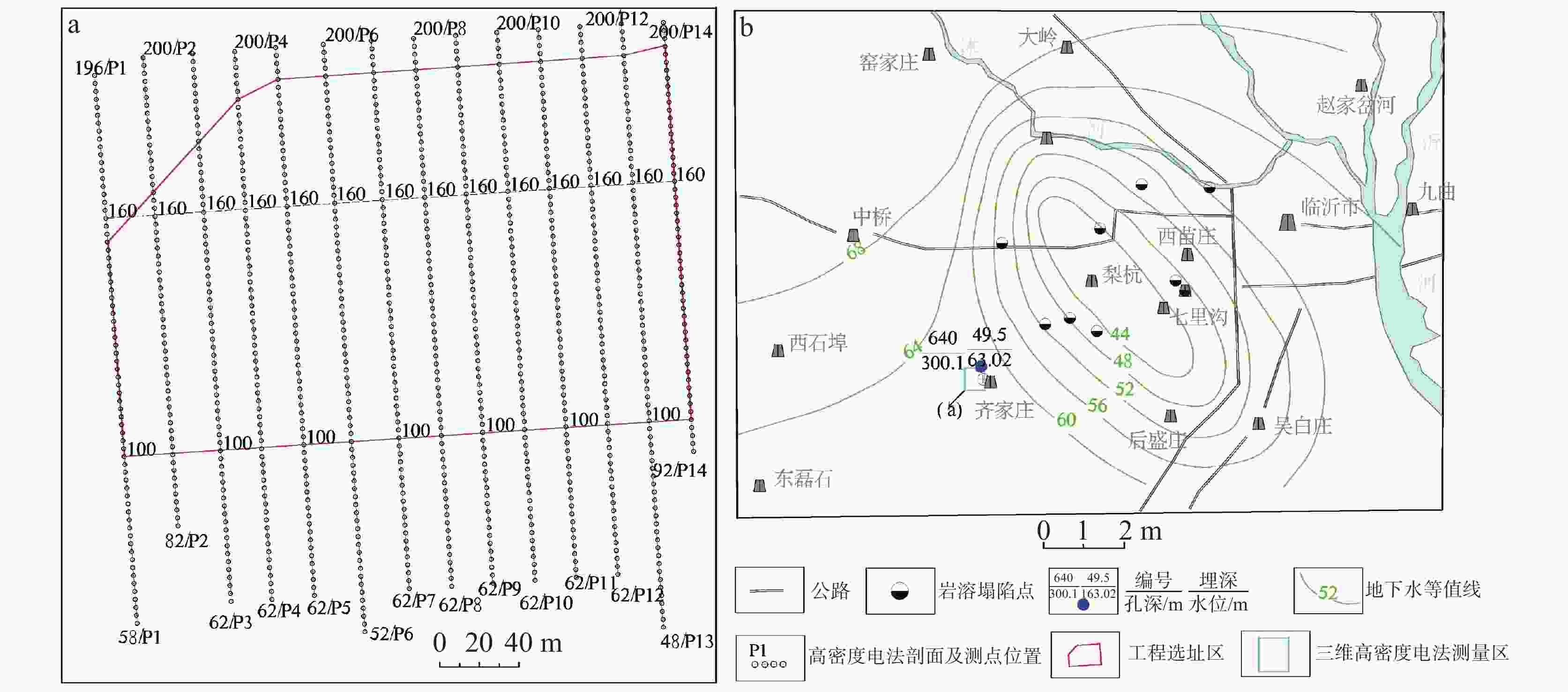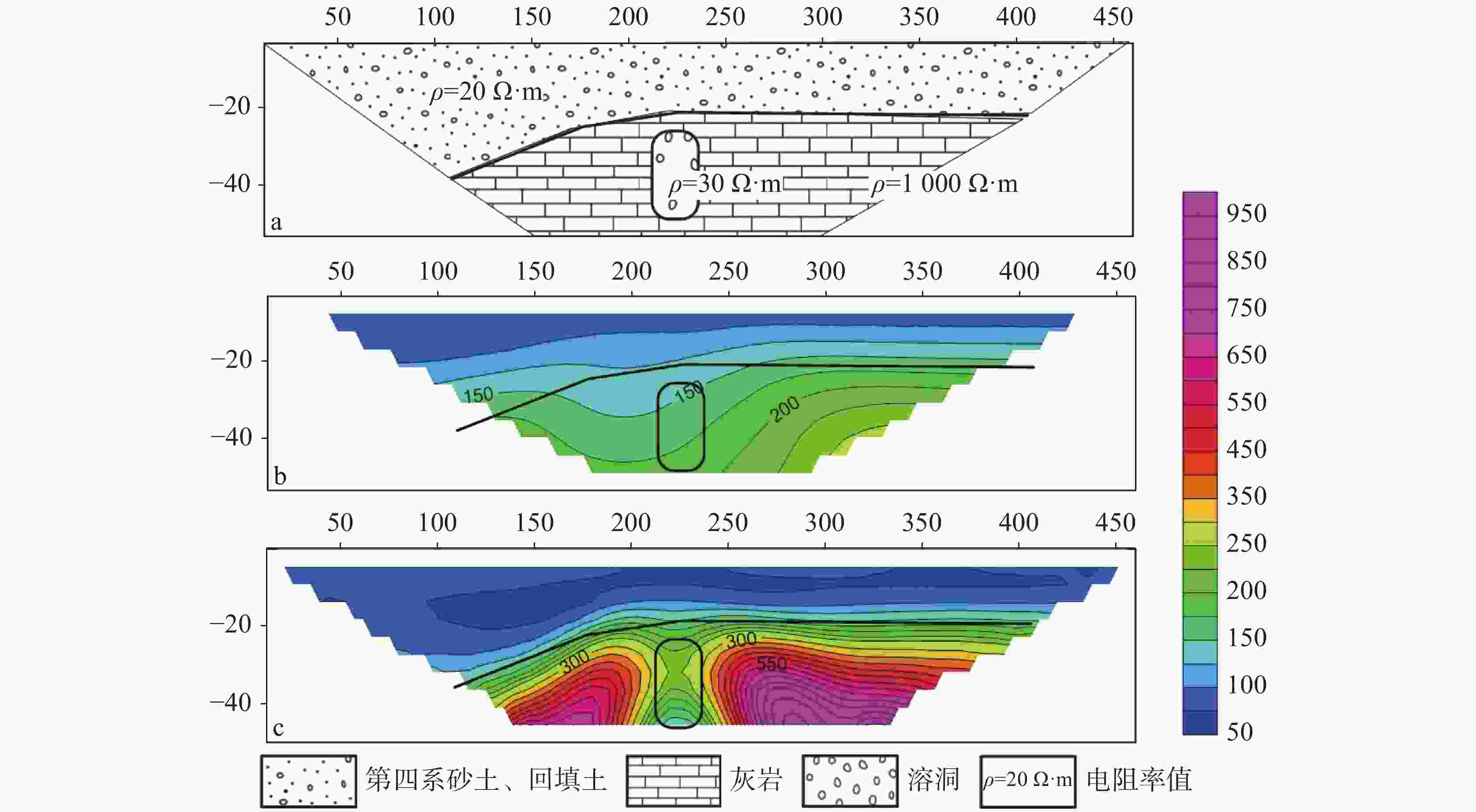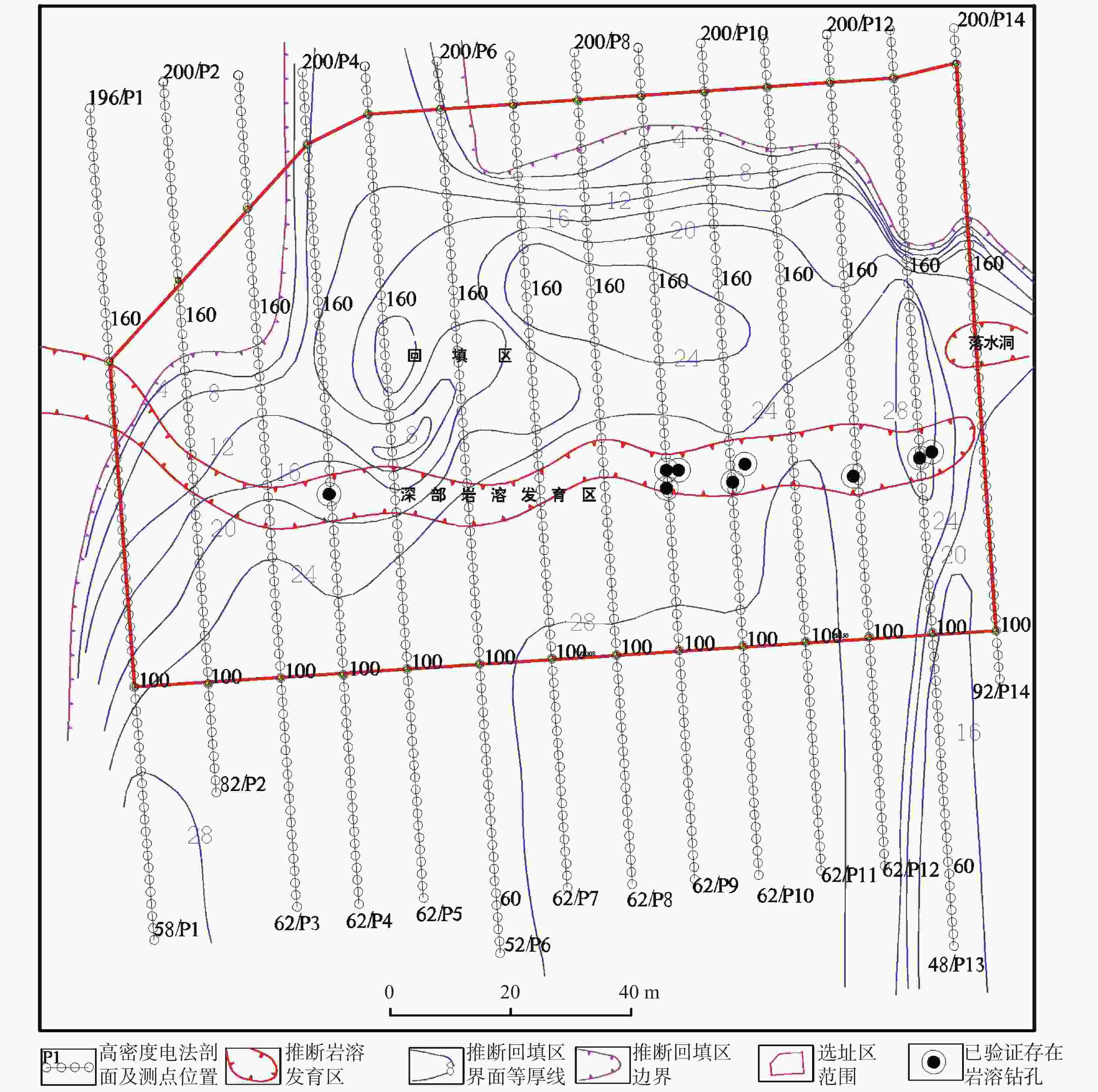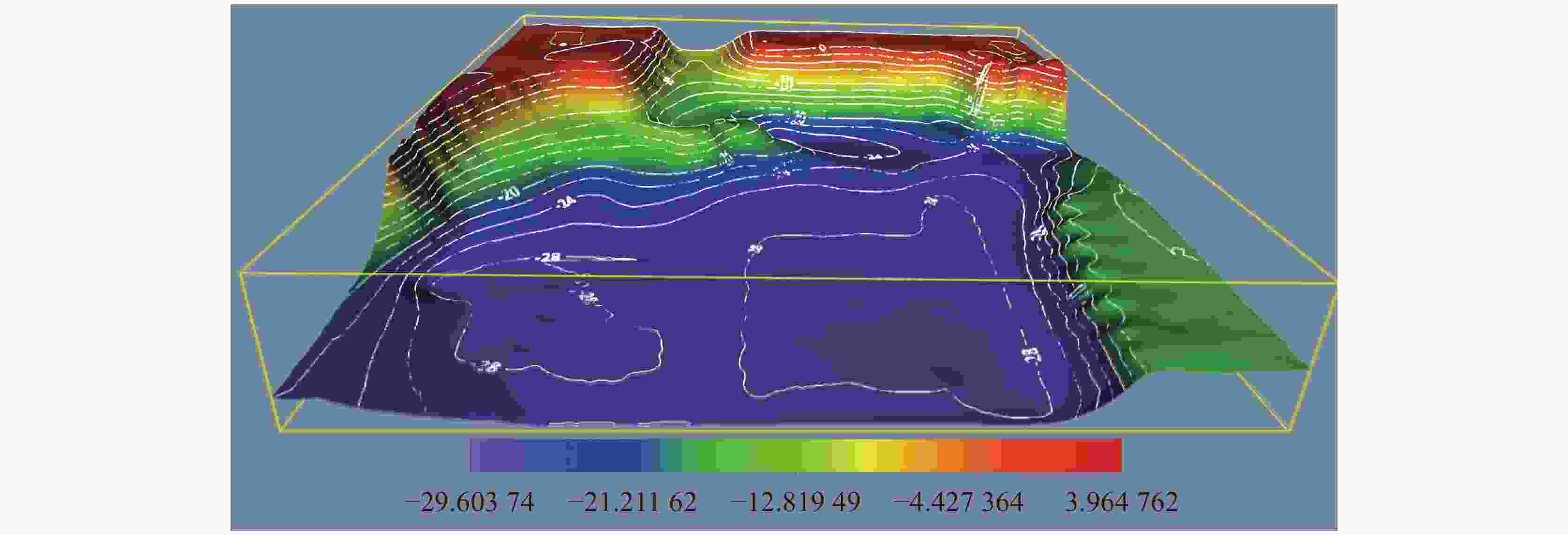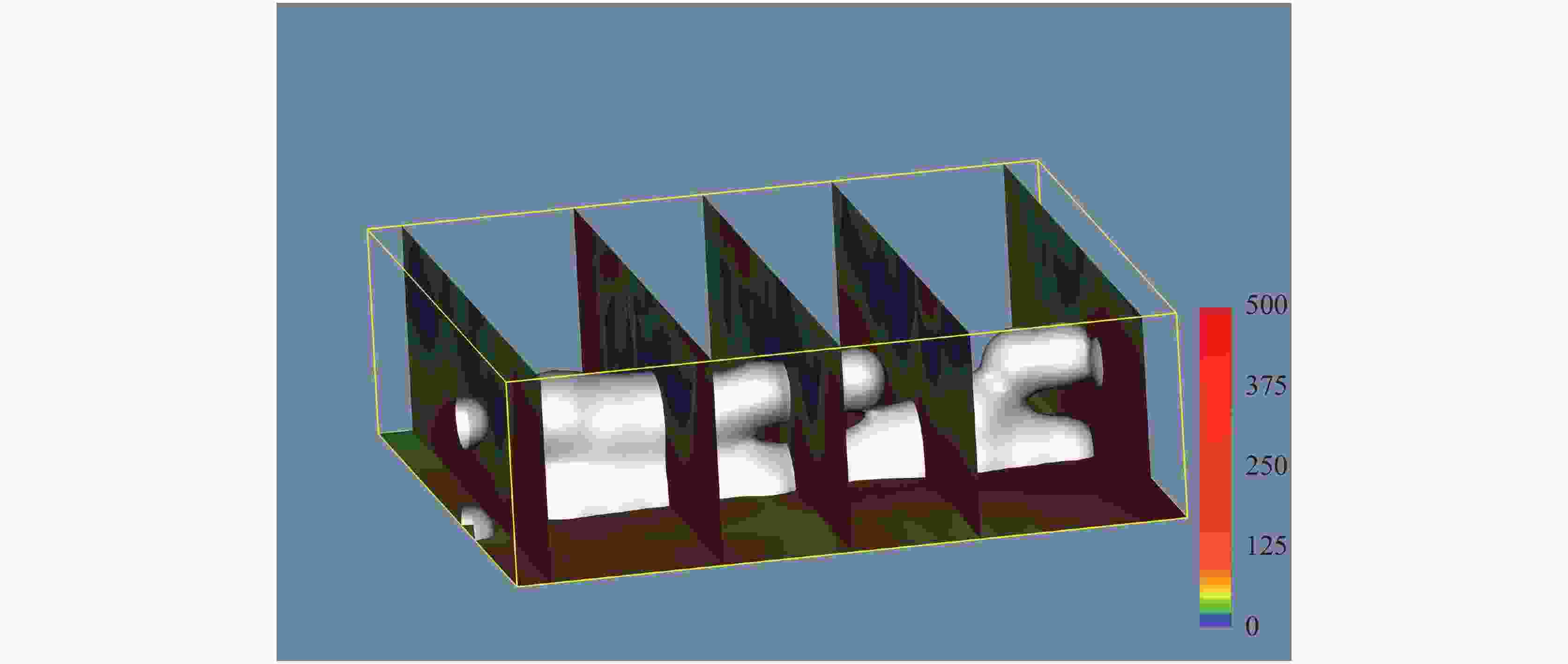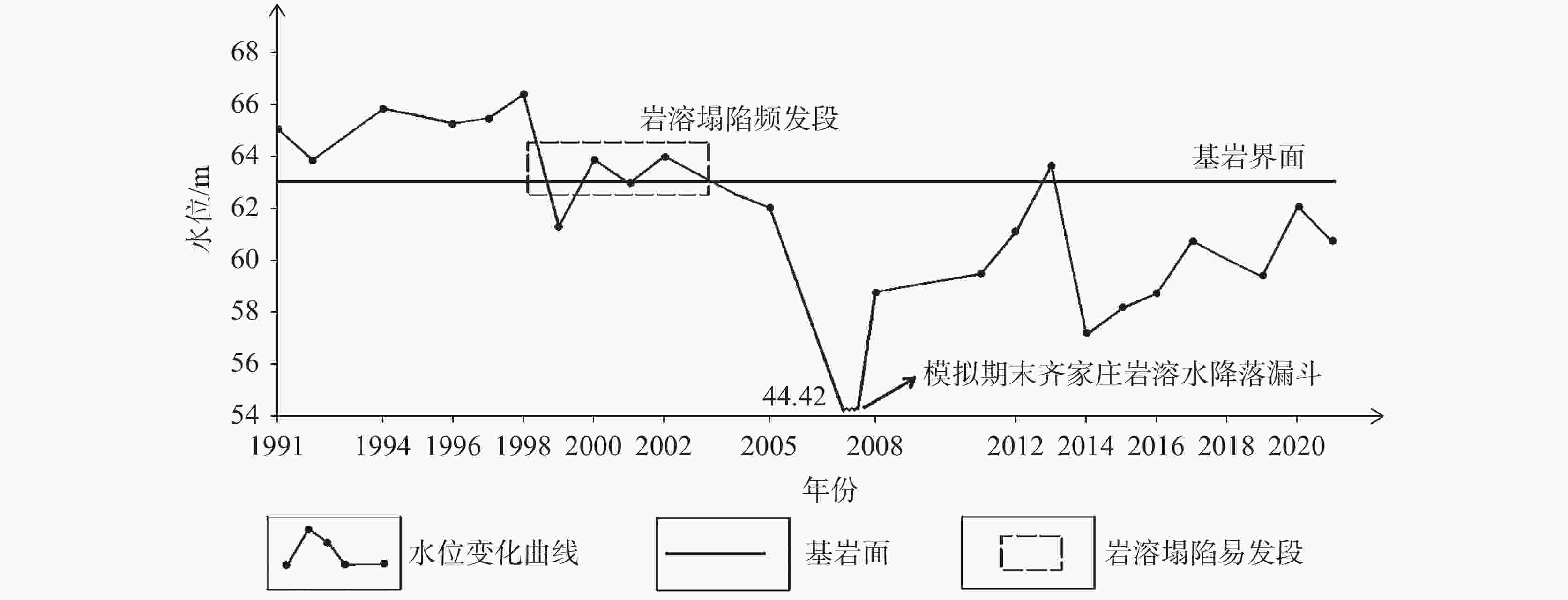Response of 3D high-density electrical method to the interface of rock (soil) layer and karst collapse
-
摘要: 在岩溶发育区开展三维高密度电阻率法勘察,建立理想的地电模型,并对已完成的三维高密度电法区开展数值模拟。采用有限差分和阻尼最小二乘法进行正、反演计算,分析其电场响应特征,并选择部分工程勘察孔进行验证,并反复推演,提升模拟成果准确度。将回填土与基岩界面、岩溶以三维方式表达。结果表明:采用数值模拟计算在物性差异明显情况下,高密度电法对界面、岩溶的刻画详细;三维高密度电法包含大量地电信息,反演结果三维可视化更加直观,为下一步工程建设提供了依据。Abstract:
Karst ground collapse occurs frequently in karst areas in China, which can easily lead to a series of hazards such as road deformation, house destruction and pipeline rupture. Karst collapse is uncertain, hidden and sudden, which poses a great threat to people's lives and property. Moreover, karst collapse is potential to facilitate the connection between surface water and groundwater, which may lead to the intermingling of these two water sources and subsequently contribute to groundwater contamination. Therefore, karst survey is of great significance to urban planning and disaster prevention and reduction. However, within the complex urban environment, accurately depicting karst morphology presents a significant challenge for geophysical exploration. Linyi City of Shandong Province, located in the west of the Tanlu Fault Zone, is one of the important temperate areas of karst development in the world. This city is especially characterized by soluble carbonate strata of Cambrian system and Ordovician system. The survey area is located in the monoclinic hydrogeological unit of Linyi, where karst fissure water is developed. In the past, the disorderly exploitation of groundwater led to frequent flowing of groundwater and many occurrences of karst collapse. In this study, we carried out 3D high-density electrical surveys in the study area, and laid 14 lines for high-density electrical survey at intervals of 12 m between each measuring line and 2 m between each measuring point. We also adopted the Wenner device, setting 25 as the maximum isolation coefficient. In this study, we firstly analyzed the physical properties of rocks in the study area, the results of which provided a physical basis for us to utilize the high-density electrical method for dividing stratigraphic boundaries and detecting karst. Subsequently, we established a geoelectric model and a 3D geoelectric structure of the study area to analyze the response characteristics of 3D high-density electrical method. Afterward, we selected some engineering exploration holes for verification and repeated deduction to improve the accuracy of simulation results. Taking P10 section as an example, we drilled holes at Point 127 for verification. According to geological records, a karst cave with a thickness of 4.1 m was found at the position of 24–28.1 m, which was basically consistent with the predicted results. The results show as follows. (1) Based on the combination of forward and backward numerical simulation, the inversion results are believed to be reliable. (2) The 3D high-density resistivity method can provide a substantial amount of data and rich geoelectric information. It clearly reflects the interface between Quaternary strata and limestone, and offers an intuitive visualization of karst caves, making it highly effective in engineering site selection. (3) The analysis indicates that the karst drawdown funnel in Linyi City shifted from Lihang–Hougangtou in 2003 to Qijiazhuang village in 2007, during which karst collapse occurred frequently. Since 2012 after the nearby karst groundwater well that was overly exploited was closed, no karst collapse has occurred again. However, the early karst development left behind some caves, so thorough surveying should be conducted during urban construction. In conclusion, in cases where there are significant differences in physical properties, the high-density resistivity method can effectively characterize the interface and karst features in detail. It can also encompass extensive geoelectric information. Moreover, the 3D visualization of inversion results can enhance the clarity of the findings. This approach provides a solid foundation for subsequent engineering construction. -
Key words:
- 3D high density /
- karst collapse /
- response characteristics /
- numerical simulation
-
表 1 区内岩、土层电性统计表
Table 1. Electrical properties of rocks and soil layers in the study area
地质代号 岩性 电阻率ρ/Ω·m 平均值 变化范围 Q 回填土 25 15~100 临沂组黏土、砂土 17 10~50 Omt 马家沟组土峪段
灰岩、白云岩1 000 150~ 3 370 含水、含泥溶洞 <50 未充填的溶洞 >3 000 表 2 推测溶洞位置
Table 2. Inferred location of the karst cave
线号 点位 顶部距地
表距离/m底部距地
表距离/m线号 点位 顶部距地
表距离/m底部距地
表距离/m线号 点位 顶部距地
表距离/m底部距地
表距离/mP1 143 −20 −27 P5 130 −42 −48 P10 131 −28 −48 P1 145 −20 −27 P5 132 −42 −48 P10 133 −28 −48 P1 147 −20 −27 P6 123 −25 −48 P10 134 −28 −48 P1 149 −20 −27 P6 125 −25 −48 P11 125 −28 −48 P1 151 −20 −27 P6 127 −25 −48 P11 127 −28 −48 P1 154 −20 −27 P6 129 −25 −48 P11 129 −28 −48 P2 126 −24 −48 P7 126 −26 −48 P11 131 −28 −48 P2 128 −24 −48 P7 128 −26 −48 P11 133 −28 −48 P2 130 −24 −48 P7 130 −26 −48 P11 135 −28 −48 P2 132 −24 −48 P7 132 −26 −48 P12 124 −25 −48 P3 126 −24 −48 P8 130 −25 −48 P12 126 −25 −48 P3 128 −24 −48 P8 132 −25 −48 P12 128 −25 −48 P3 130 −24 −48 P8 134 −25 −48 P12 130 −25 −48 P3 132 −24 −48 P8 136 −25 −48 P12 132 −25 −48 P4 126 −36 −48 P9 127 −28 −48 P12 134 −25 −48 P4 128 −36 −48 P9 129 −28 −48 P12 136 −25 −48 P4 130 −36 −48 P9 131 −28 −48 P12 137 −25 −48 P4 132 −36 −48 P9 133 −28 −48 P14 144 −22 −48 P4 133 −36 −48 P10 125 −28 −48 P14 146 −22 −48 P5 126 −42 −48 P10 127 −28 −48 P14 148 −22 −48 P5 128 −42 −48 P10 129 −28 −48 P14 150 −22 −48 -
[1] 王晓光, 郭常来, 何海洋, 刘强. 地下水降落漏斗分类研究[J]. 地质与资源, 2019, 28(5):487-492. doi: 10.3969/j.issn.1671-1947.2019.05.012WANG Xiaoguang, GUO Changlai, HE Haiyang, LIU Qiang. Study on the classification of groundwater depression cone[J]. Geology and Resources, 2019, 28(5): 487-492. doi: 10.3969/j.issn.1671-1947.2019.05.012 [2] 韦跃龙, 蒋忠诚, 陈伟海, 罗书文, 李成展, 吴华英, 罗劬侃. 山东岩溶地貌特征及其形成演化分析[J]. 地球学报, 2020, 41(4):561-574.WEI Yuelong, JIANG Zhongcheng, CHEN Weihai, LUO Shuwen, LI Chengzhan, WU Huaying, LUO Qukan. An analysis of characteristics, formation and evolution of karst landforms, Shandong Province[J]. Acta Geoscientica Sinica, 2020, 41(4): 561-574. [3] 姚春梅, 冯克印, 王元波, 王小燕, 任翠爱, 刘善军. 数值模拟在岩溶塌陷预警系统建设中的应用:以临沂市城区岩溶塌陷为例[J]. 水文地质工程地质, 2007, 34(4):94-97, 102.YAO Chunmei, FENG Keyin, WANG Yuanbo, WANG Xiaoyan, REN Cuiai, LIU Shanjun. Application of numerical modeling of groundwater flow to the construction of early-warning system of karst collapse: Exemplified by the karst collapse in the Linyi urban area[J]. Hydrogeology & Engineering Geology, 2007, 34(4): 94-97, 102 [4] 吴远斌, 罗伟权, 殷仁朝, 刘之葵, 戴建玲, 潘宗源, 周富彪. 重庆市龙泉村—庆丰山村岩溶塌陷分布规律与成因机制[J]. 中国岩溶, 2021, 40(6):932-942.WU Yuanbin, LUO Weiquan, YIN Renchao, LIU Zhikui, DAI Jianling, PAN Zongyuan, ZHOU Fubiao. Distribution law and genetic mechanism of karst collapse in Longquan village–Qingfengshan village, Chongqing[J]. Carsologica Sinica, 2021, 40(6): 932-942. [5] 陆泽峰. 高山峡谷地区桥址区岩溶发育特征地球物理勘察[J]. 物探与化探, 2021, 45(1):252-256.LU Zefeng. Geophysical exploration of karst development characteristics in bridge site of the alpine gorge area[J]. Geophysical and Geochemical Exploration, 2021, 45(1): 252-256. [6] 李谭伟, 李振兴, 葛延明, 邬远明. 综合物探方法在株洲湘江大桥勘察中的应用[J]. 物探与化探, 2021, 45(3):785-792.LI Tanwei, LI Zhenxing, GE Yanming, WU Yuanming. The application of comprehensive geophysical prospecting method to the investigation of Xiangjiang bridge in Zhuzhou[J]. Geophysical and Geochemical Exploration, 2021, 45(3): 785-792. [7] 满洪敏. 临沂市的岩溶塌陷灾害及防治对策[J]. 灾害学, 2002, 17(1):46-50. doi: 10.3969/j.issn.1000-811X.2002.01.010MAN Hongmin. Hazards of karst collapse and countermeasures in Linyi City[J]. Journal of Catastrophology, 2002, 17(1): 46-50. doi: 10.3969/j.issn.1000-811X.2002.01.010 [8] 谭大龙, 庹先国, 赵思维. 高密度电法在西岭雪山蓄水池稳定性探测中的应用[J]. 物探化探计算技术, 2011, 33(2):159-164, 107. doi: 10.3969/j.issn.1001-1749.2011.02.009TAN Dalong, TUO Xianguo, ZHAO Siwei. Applications of stability exploration with high-density electrical method in the Xiling snow mountain reservoir[J]. Computing techniques for Geophysical and Geochemical Exploration, 2011, 33(2): 159-164, 107. doi: 10.3969/j.issn.1001-1749.2011.02.009 [9] 马静晨, 李娜. 三维高密度电法在隐伏构造富水性勘探中的应用[J]. 城市地质, 2014, 9(1):43-45. doi: 10.3969/j.issn.1007-1903.2014.01.011MA Jingchen, LI Na. Application of 3D high-density electrical method to detection of the groundwater exploration in concealed structures[J]. Urban Geology, 2014, 9(1): 43-45. doi: 10.3969/j.issn.1007-1903.2014.01.011 [10] 苏永军, 黄忠峰, 范翠松, 刘继红, 刘宏伟, 张国利. 三维高密度电法在海水入侵界面探测中应用:以莱州湾地区为例[J]. 地质调查与研究, 2018, 41(2):134-137, 152.SU Yongjun, HUANG Zhongfeng, FAN Cuisong, LIU Jihong, LIU Hongwei, ZHANG Guoli. Application of the three-dimensional high density resistivity method to detection the interface of saltwater intrusion: A case study of Laizhou bay[J]. Geological Survey and Research, 2018, 41 (2): 134-137, 152. [11] 岑洋, 许孝臣, 江晓益, 谭磊. 三维高密度电法在土石坝渗漏探测中的应用[J]. 地质论评, 2021, 67(Suppl.1):1-2.CEN Yang, XU Xiaochen, JIANG Xiaoyi, TAN Lei. Application of 3D high-density resistivity method in leakage detection of embankment dam[J]. Geological Review, 2021, 67(Suppl.1): 1-2. [12] 王洁. 三维高密度电法在城市地下岩溶塌陷区探测中的应用[J]. 工程地球物理学报, 2021, 18(1):107-112. doi: 10.3969/j.issn.1672-7940.2021.01.013WANG Jie. Application of three-dimensional high-density electrical method in urban underground karst collapse area detection[J]. Chinese Journal of Engineering Geophysics, 2021, 18(1): 107-112. doi: 10.3969/j.issn.1672-7940.2021.01.013 [13] 高阳, 熊华山, 彭明涛, 江兆南, 范飞越. 三维高密度电法技术及其在岩溶塌陷勘探中的应用[J]. 桂林理工大学学报, 2017, 37(3):417-421. doi: 10.3969/j.issn.1674-9057.2017.03.004GAO Yang, XIONG Huashan, PENG Mingtao, JIANG Zhaonan, FAN Feiyue. Three-dimensional high-density electrical technique and application of geophysical prospecting to karst collapse[J]. Journal of Guilin University of Technology, 2017, 37(3): 417-421. doi: 10.3969/j.issn.1674-9057.2017.03.004 [14] 孟凡松, 张刚, 陈梦君, 李怀良. 高密度电阻率法二维勘探数据的三维反演及其在岩溶探测中的应用[J]. 物探与化探, 2019, 43(3):672-678.MENG Fansong, ZHANG Gang, CHEN Mengjun, LI Huailiang. 3-D inversion of high density resistivity method based on 2-D high-density electrical prospecting data and its engineering application[J]. Geophysical and Geochemical Exploration, 2019, 43(3): 672-678. [15] 黄真萍, 吴伟达, 张义, 胡晓娟. 三维高密度电法高分辨数值模拟与分析[J]. 工程地质学报, 2015, 23(4):795-800.HUANG Zhenping, WU Weida, ZHANG Yi, HU Xiaojuan. Numerical simulation and analysis of three-dimensional high-density resistivity method with high resolution[J]. Journal of Engineering Geology, 2015, 23(4): 795-800. [16] 王钧, 朱国维. 基于Res3dinv软件的三维高密度电法成像效果分析[J]. 工程地球物理学报, 2022, 19(1):117-125. doi: 10.3969/j.issn.1672-7940.2022.01.016WANG Jun, ZHU Guowei. Analysis of the effect of three-dimensional high-density electrical imaging based on Res3dinv software[J]. Chinese Journal of Engineering Geophysics, 2022, 19(1): 117-125. doi: 10.3969/j.issn.1672-7940.2022.01.016 [17] 朱紫祥, 胡俊杰. 高密度电法在岩溶地区溶洞勘查中的应用[J]. 工程地球物理学报, 2017, 14(3):290-293. doi: 10.3969/j.issn.1672-7940.2017.03.006ZHU Zixiang, HU Junjie. Application of high-density electrical method to exploration of karst caves[J]. Chinese Journal of Engineering Geophysics, 2017, 14(3): 290-293. doi: 10.3969/j.issn.1672-7940.2017.03.006 [18] 郑智杰, 甘伏平, 曾洁. 不同深度岩溶管道的高密度电阻率法反演特征[J]. 中国岩溶, 2015, 34(3):292-297. doi: 10.11932/karst20150313ZHENG Zhijie, GAN Fuping, ZENG Jie. Inversion characteristics of high-density resistivity method on karst conduits at varied depths[J]. Carsologica Sinica, 2015, 34(3): 292-297. doi: 10.11932/karst20150313 [19] 郑智杰, 曾洁, 甘伏平. 装置和电极距对岩溶管道高密度电法响应特征的影响研究[J]. 水文地质工程地质, 2016, 43(5):161-165, 172.ZHENG Zhijie, ZENG Jie, GAN Fuping. Research on the effect of device and electrode distance on the characteristics of high-density resistivity method in karst pipeline[J]. Hydrogeology & Engineering Geology, 2016, 43(5): 161-165, 172. [20] 朱欣月, 李三百, 冯夏庭, 康志江, 樊洪卓, 黄孝特. 基于数值法的三维缝洞溶蚀演化主控因素研究[J]. 中国岩溶, 2021, 40(6):943-951. doi: 10.11932/karst20210604ZHU Xinyue, LI Sanbai, FENG Xiating, KANG Zhijiang, FAN Hongzhuo, HUANG Xiaote. Numerical investigation on the main controlling factors of the dissolution evolution of three-dimensional fracture-cavity reservoirs[J]. Carsologica Sinica, 2021, 40(6): 943-951. doi: 10.11932/karst20210604 [21] 韩凯, 梁东辉, 甘伏平, 黄芬. 利用高精度示踪技术和大功率充电法确定地下河系统的管道分布特征:以毛村地下河系统为例[J]. 中国岩溶, 2021, 40(5):884-893.HAN Kai, LIANG Donghui, GAN Fuping, HUANG Fen. Utilizing high-precision tracer technology and high-powered mise-a-la-masse method to determine the pipeline distribution characteristics of underground river system: A case study in Maocun underground river system[J]. Carsologica Sinica, 2021, 40(5): 884-893. [22] 徐佳, 朱鲁, 翟培合. 基于Voxler平台的电法数据体三维可视化[J]. 工程地球物理学报, 2014, 11(6):772-775. doi: 10.3969/j.issn.1672-7940.2014.06.006XU Jia, ZHU Lu, ZHAI Peihe. The 3D visualization interpretation of electrical data based on the Voxler platform[J]. Chinese Journal of Engineering Geophysics, 2014, 11(6): 772-775. doi: 10.3969/j.issn.1672-7940.2014.06.006 [23] 王建军, 强建科, 李成香, 徐卫权. 高密度电法在地面塌陷勘察中的应用[J]. 工程地球物理学报, 2005, 2(3):232-234. doi: 10.3969/j.issn.1672-7940.2005.03.012WANG Jianjun, QIANG Jianke, LI Chengxiang, XU Weiquan. The application of high-density resistivity method to ground subsidence[J]. Chinese Journal of Engineering Geophysics, 2005, 2(3): 232-234. doi: 10.3969/j.issn.1672-7940.2005.03.012 [24] 郑智杰, 敖文龙, 曾洁, 甘伏平, 张伟. 综合物探法在柳州泗角村岩溶塌陷区调查中的应用[J]. 水文地质工程地质, 2017, 44(5): 143-149.ZHENG Zhijie, AO Wenlong, ZENG Jie, GAN Fuping, ZHANG Wei. Application of integrated geophysical methods to karst collapse investigation in the Sijiao village near Liuzhou[J]. Hydrogeology & Engineering Geology, 2017, 44(5): 143-149. [25] 李清春, 冯克印, 郑庭明, 董强. 临沂市城区岩溶塌陷特征及成因分析[J]. 山东国土资源, 2005, 21(9):61-64. doi: 10.3969/j.issn.1672-6979.2005.09.021LI Qingchun, FENG Keyin, ZHENG Tingming, DONG Qiang. Characteristics and origin analysis of karst collapse in Linyi City[J]. Shandong Land and Resources, 2005, 21(9): 61-64. doi: 10.3969/j.issn.1672-6979.2005.09.021 [26] 郭士昌, 姚春梅, 张乐进, 李景波, 卞加升. 临沂市城区岩溶地下水流模拟[J]. 山东国土资源, 2009, 25(4):21-24. doi: 10.3969/j.issn.1672-6979.2009.04.010GUO Shichang, YAO Chunmei, ZHANG Lejin, LI Jingbo, BIAN Jiasheng. Simulation of karst groundwater flow in Linyi City[J]. Shandong Land and Resources, 2009, 25(4): 21-24. doi: 10.3969/j.issn.1672-6979.2009.04.010 [27] A Dey, H F Moreison. Resistivity modeling for arbitrarily shaped three-dimensional structures[J]. Geophysics, 1979, 44(4): 753-780. doi: 10.1190/1.1440975 [28] Loke M H, Barker R D. Rapid least-squares inversion of apparent resistivity pseudosections by a quasi-Newton method[J]. Geophysical Prospecting, 1996, 44: 131-152. doi: 10.1111/j.1365-2478.1996.tb00142.x [29] 姜国庆, 徐士银, 金永念, 陈丁, 卢进添. 薄覆盖隐伏断层电场响应特征研究:以废黄河断裂为例[J]. 地球物理学进展, 2016, 31(4):1824-1833. doi: 10.6038/pg20160454JIANG Guoqing, XU Shiyin, JIN Yongnian, CHEN Ding, LU Jintian. Electric field response characteristics of buried fault with thin overburden layer: The example of Feihuanghe fault[J]. Progress in Geophysics, 2016, 31(4): 1824-1833. doi: 10.6038/pg20160454 [30] 黄真萍, 胡艳, 朱鹏超, 李文灵. 高密度电阻率勘测方法分辨率研究与探讨[J]. 工程地质学报, 2014, 22(5):1015-1021.HUANG Zhenping, HU Yan, ZHU Pengchao, LI Wenling. Analysis of resolution influence factors of high-density electrical method and its application[J]. Journal of Engineering Geology, 2014, 22(5): 1015-1021. [31] 周正, 李大华, 廖云平, 林军志, 张烨, 陈洪凯, 祁永爱, 王贺. 重庆中梁山岩溶地面塌陷特征及形成机理[J]. 中国岩溶, 2022, 41(1):67-78. doi: 10.11932/karst20220103ZHOU Zheng, LI Dahua, LIAO Yunping, LIN Junzhi, ZHANG Ye, CHEN Hongkai, QI Yongai, WANG He. Characteristics and formation mechanism of karst ground collapse in Zhongliangshan area, Chongqing[J]. Carsologica Sinica, 2022, 41(1): 67-78. doi: 10.11932/karst20220103 -




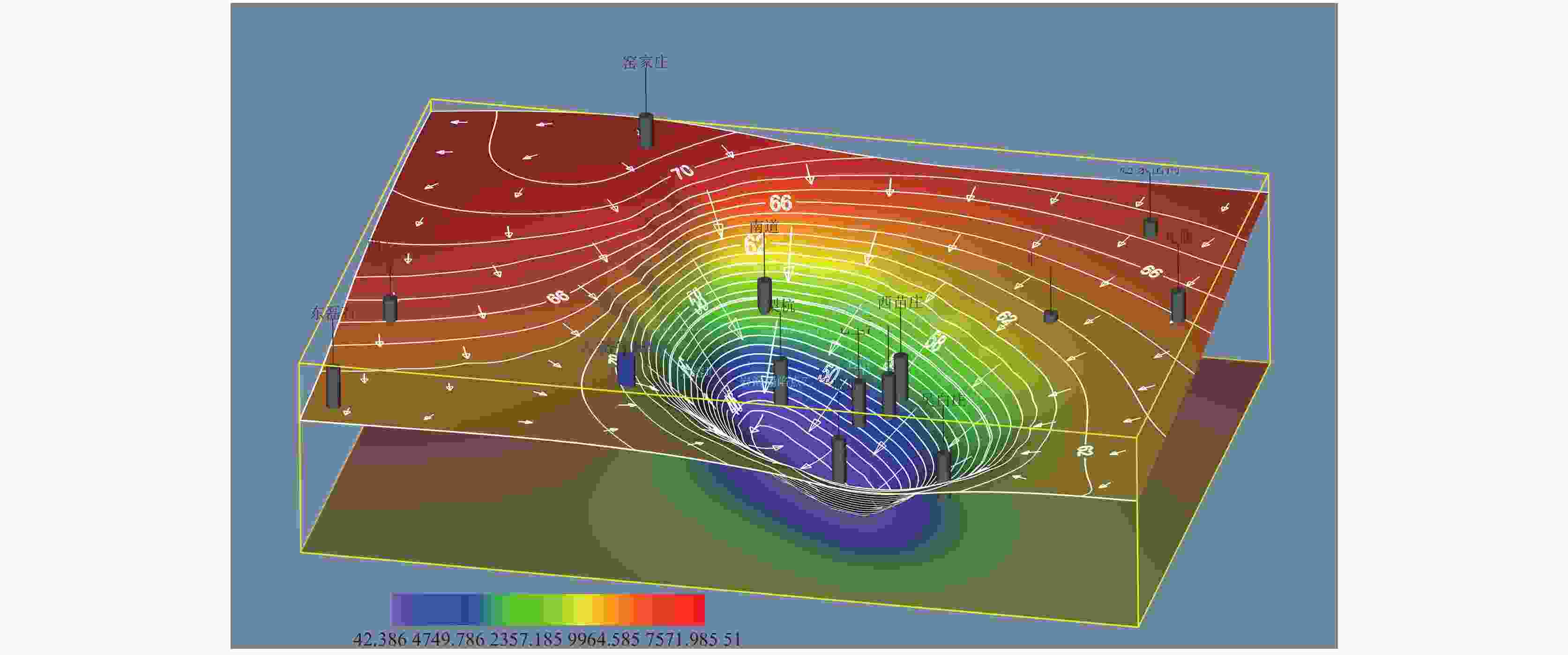
 下载:
下载:
